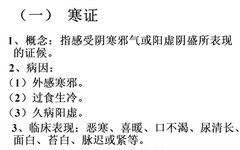II. Differentiation of Cold and Heat
Cold and heat are fundamental principles for distinguishing and judging the nature of diseases. Cold and heat primarily reflect the rise and fall of Yin and Yang in diseases, as well as the nature of pathogenic factors being Yin or Yang.
It is important to clarify: While aversion to cold and fever are major criteria for distinguishing between heat and cold syndromes, aversion to cold and fever are phenomena of the disease, while cold syndrome and heat syndrome represent an understanding of the essence of the disease, thus the two cannot be equated.
👉 This is very common in clinical practice, for example, fever indicates heat, while aversion to cold indicates cold.
Watch the video to learn more
(1) Cold Syndrome
1. Concept: Refers to symptoms resulting from the invasion of cold pathogenic factors or Yang deficiency with excessive Yin.
2. Causes:
(1) External invasion of cold pathogens (external evil)
(2) Overconsumption of cold foods
(3) Prolonged illness leading to Yang deficiency (internal evil)
3. Clinical manifestations: Aversion to cold, preference for warmth, thirst or lack thereof, clear and frequent urination, pale complexion, white tongue coating, slow or tight pulse.
4. Key points for differentiation: Aversion to cold and preference for warmth are characteristic features.
👉 For example, cold evil is a Yin cold evil that harms Yang Qi, leading to insufficient Yang Qi in the kidneys, which decreases the ability to evaporate fluids, resulting in increased urination.
👉 For instance, aversion to cold and preference for warmth may lead to difficulty urinating, resulting in body edema.
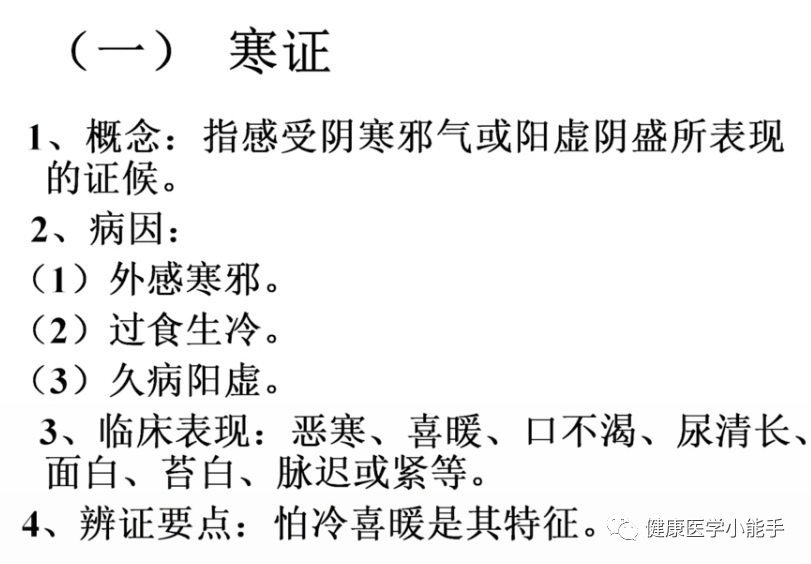
5. It is worth noting that the classification of cold syndromes and their meanings should be familiar.
(1) Excess Cold Syndrome: Cold pathogens invade, onset is acute, body is strong and solid, characteristic of excess syndrome cold.
(2) Deficiency Cold Syndrome: Cold damages the body, weak and sickly, characteristic of cold deficiency syndrome.
(3) Exterior Cold Syndrome: Cold pathogens invade the exterior, characterized by sudden aversion to cold.
(4) Interior Cold Syndrome: Cold affects the internal organs or insufficient Yang Qi, primarily presenting with internal organ symptoms.
(2) Heat Syndrome
1. Concept: Refers to symptoms resulting from the invasion of Yang heat pathogens or Yin deficiency with excessive Yang.
2. Causes:
External invasion of summer heat.
Overconsumption of spicy foods.
Prolonged illness damaging Yin.
Emotional distress leading to fire.
👉 For example, a person who is often stressed may easily develop high blood pressure due to Qi stagnation.
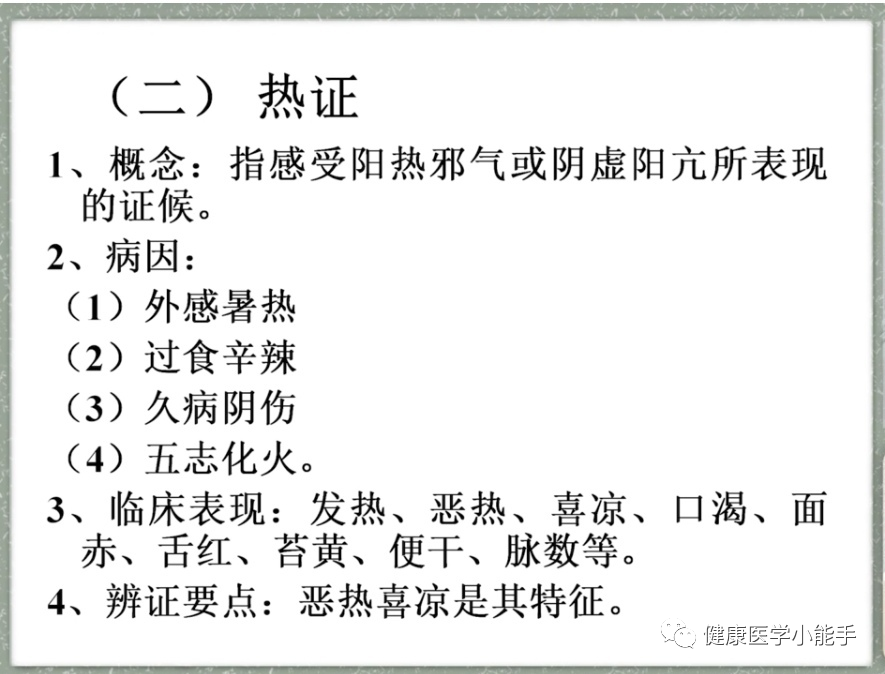
3. Clinical manifestations: Fever, aversion to heat, preference for coolness, thirst, red face, red tongue, yellow coating, dry stools, rapid pulse, etc.
4. Key points for differentiation: Aversion to heat and preference for coolness are characteristic features.
5. Based on the body’s response to heat pathogens, the state of Zheng Qi (upright Qi) can be classified into four types, and it is essential to be familiar with the classification and meanings of heat syndromes.
(1) Excess Heat Syndrome: Fire heat invades, Yang Qi is excessive, severe condition, strong body, characteristic of excess heat syndrome.
(2) Deficiency Heat Syndrome: Body fluids are deficient, Yang Qi is relatively strong, often due to prolonged illness, characteristic of deficiency heat syndrome.
👉 Tips: Deficiency heat often presents as low-grade fever.
(3) Exterior Heat Syndrome: Heat pathogens invade the exterior, characterized by severe onset and mild aversion to cold.
👉 Tips: Exterior heat always has some aversion to cold, even if the heat pathogen is present.
(4) Interior Heat Syndrome: Yang heat affects the internal organs, or Yin fluids are deficient leading to excessive fire.
👉 Tips: Among these excess heat syndromes, exterior heat is easier to treat, while interior heat is the most difficult to treat.
👉 Comparison: Cold syndrome and heat syndrome can be distinguished by what they fear and prefer. Thirst indicates heat syndrome, while lack of thirst indicates cold syndrome. Frequent urination indicates cold syndrome, while infrequent urination indicates heat syndrome, as it is evaporated by heat.
III. Differentiation of Deficiency and Excess
Deficiency and excess are two fundamental principles for distinguishing the strength and weakness of pathogenic and upright Qi, and also for identifying the nature of disease syndromes. The struggle between pathogenic and upright Qi is the fundamental contradiction in diseases; every disease has a distinction between deficiency and excess, and differentiating deficiency and excess can provide a basis for supporting upright Qi and eliminating pathogenic factors.
“When pathogenic Qi is strong, it is excess” and when pathogenic Qi is strong, the treatment should primarily focus on attacking the pathogenic factors.
👉 For example, when pathological products accumulate, it indicates excess. For instance, if one is severely sunburned and has a high fever, the heat pathogen is strong, invading the body, resulting in high fever as a pathological product.
“When essence and Qi are depleted, it is deficiency,” meaning that the main aspect of the contradiction is the deficiency of upright Qi, and the treatment should primarily focus on tonifying deficiency.
(1) Excess Syndrome
1. Concept: Refers to symptoms resulting from the invasion of external pathogens or the accumulation of pathological products.
2. Causes:
(1) Six excesses, epidemics, insect toxins.
(2) Phlegm, fluids, dampness, blood stasis, concentrated toxins.
(3) Qi stagnation, food accumulation.
👉 This refers to severe impacts on the body, where the person feels intense pain and discomfort due to the abundance of pathogenic factors and pathological products, which directly and clearly affect the body. 👉 For example, COVID-19 can lead to respiratory difficulties and chest tightness in some individuals.
3. Clinical manifestations: It is difficult to represent all excess syndromes with a few symptoms, but they typically exhibit abundant pathogenic Qi, accumulation of evils, and strong Zheng Qi, with intense struggles between pathogenic and upright Qi, manifesting as excess, strong, and stagnant characteristics.
4. Key points for differentiation:
(1) New illness, explosive illness, severe condition, strong constitution.
(2) There is a clear and identifiable cause.
👉 For example, during a battle, if the enemy is numerous and our troops are also numerous, the battle is intense; this situation represents excess.
(2) Deficiency Syndrome
1. Concept: Refers to various weaknesses primarily due to the deficiency of upright Qi.
2. Causes:
(1) Congenital deficiency, lack of nourishment after birth.
(2) Decreased production of essence and Qi (👉 for example, being able to eat normally but eating little, leading to a lack of energy throughout the day. Feeling weak while working, but completing the work well is a different concept).
(3) Emotional distress, overwork, sexual activity depleting Qi and essence (excessive sexual activity leading to fatigue the next day).
(4) Vomiting, diarrhea, sweating, blood loss.
(5) Prolonged illness without treatment, misdiagnosis, depleting upright Qi.
👉 Tips: The degree of suffering caused by the disease is mild, but it lasts a long time.
3. Clinical manifestations: It is difficult to represent all deficiency syndromes with a few symptoms, but they typically exhibit insufficient upright Qi, with the pathogenic factors not being obvious, and the struggle between pathogenic and upright Qi being slow and subtle, manifesting as deficiency and low energy.
4. Key points for differentiation:
(1) Prolonged illness, slow progression, excessive depletion, weak constitution.
(2) It is relatively difficult to identify the cause.
IV. Differentiation of Yin and Yang
Yin and Yang are two fundamental principles for differentiating types of syndromes.
Since Yin and Yang represent two aspects of things, exterior-interior, cold-heat, deficiency-excess can all be distinguished by Yin and Yang, while exterior-interior and cold-heat cannot be mutually attributed, thus only Yin and Yang can serve as the guiding principles for classifying syndromes.
👉 For example, Zhang Jingyue’s “Two Principles and Six Transformations” illustrates that Yin and Yang serve as guiding principles, while the six transformations (exterior-interior, cold-heat, deficiency-excess) represent the process of disease changes.
Basic attributes of Yang: Excitement, agitation, excess, brightness, upward movement.
Basic attributes of Yin: Inhibition, tranquility, decline, darkness, downward movement.
Yang syndromes – exterior syndromes, excess syndromes, heat syndromes.
Yin syndromes – interior syndromes, deficiency syndromes, cold syndromes.
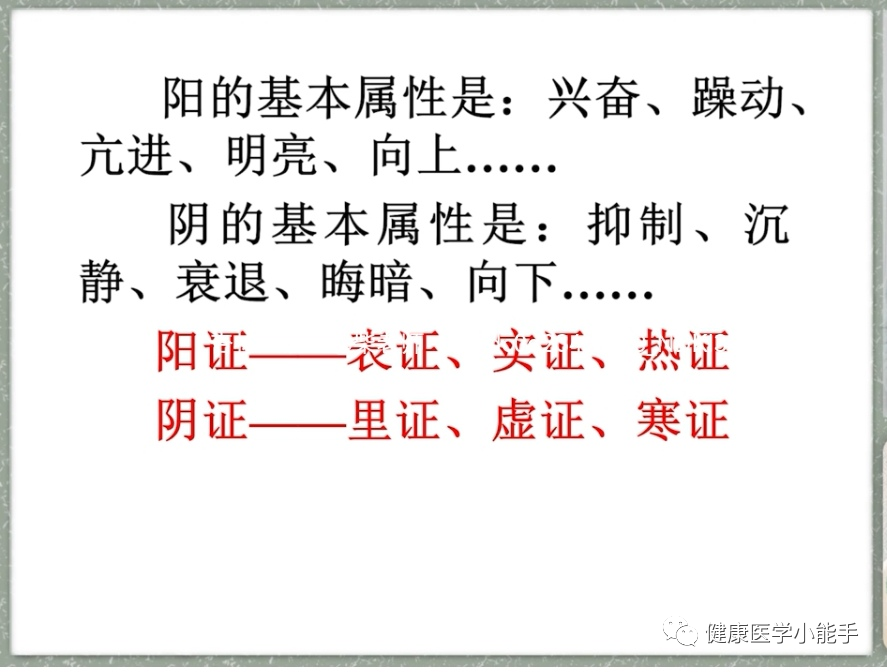
(1) Yang Deficiency Syndrome
1. Concept:: Yang Qi deficiency, leading to weakened warming, promoting, and vaporizing functions, manifesting as deficiency cold syndrome.
2. Causes:
(1) Development of Qi deficiency.
(2) Aging and decline of Mingmen fire.
(3) Overconsumption of bitter, cold, and cooling substances.
3. Clinical manifestations: Aversion to cold, cold limbs, lack of thirst, pale complexion, spontaneous sweating, deep or slow pulse, etc.
4. Key points for differentiation:: Cold signs, Qi deficiency are both present.
(2) Yin Deficiency Syndrome
1. Concept: Refers to the deficiency of body fluids, essence, and blood, leading to a reduction in the ability to restrain Yang, nourish, and moisten, manifesting as weakness.
2. Causes:
(1) After heat illness (damaging essence).
(2) Various diseases damaging Yin.
(3) Emotional distress, sexual activity.
(4) Overconsumption of warming and drying substances (👉 for example, a strong person who frequently drinks deer antler wine with sea horse may exacerbate heat).
3. Clinical manifestations: Weight loss, red cheeks, tidal fever, night sweats, five hearts heat, red tongue with little coating, thin and rapid pulse.
4. Key points for differentiation: Deficiency fire and excess inflammation are characteristic features.
(3) Yang Collapse Syndrome
1. Concept: Refers to critical symptoms when Yang Qi is extremely weak and on the verge of collapse.
2. Causes:
(1) Development of Yang Qi deficiency.
(2) Severe cold injuring Yang.
(3) Yang Qi escaping with Yin.
(4) Severe toxic stimulation, serious trauma, etc.
3. Clinical manifestations: Characterized by profuse cold sweat, cool body and limbs, weak breath, pale complexion, and a pulse that is faint and almost imperceptible.
4. Key points for differentiation: On the basis of critical illness, sudden profuse cold sweat, it should be noted that Yang collapse syndrome primarily refers to heart Yang deficiency. When Yang collapses, Yin also follows.
(4) Yin Collapse Syndrome
1. Concept:Refers to critical symptoms when Yin fluids are severely depleted and on the verge of collapse.
2. Causes:
(1) Development of Yin deficiency.
(2) Continuous sweating, vomiting, diarrhea, high fever that does not subside.
(3) Severe burns, etc.
3. Clinical manifestations: Hot, sticky sweat, burning thirst, thin and rapid pulse.
👉 For example, individuals who are thin have a higher likelihood of experiencing Yin collapse, while those who are overweight have a lower likelihood. Generally, individuals with Yin deficiency are more likely to experience Yang collapse, and vice versa.
4. Key points for differentiation: On the basis of critical illness, sudden hot, sticky sweat.
It should be noted that the transition of Yin collapse often involves multiple organs such as the heart, liver, and kidneys. When Yin collapses, Yang also follows.
Section Three
The Relationship Between the Eight Principles Differentiation
The eight principle syndromes are interrelated, possessing necessity and universality. Yin and Yang, exterior and interior, cold and heat, deficiency and excess each summarize the essence of pathological changes from different perspectives, and none of them are complete syndromes. Differentiation provides a comprehensive understanding of the location, cause, and nature of the disease.
In summary, every pathological change must have a certain cause, nature, and location, and the condition is in a state of change, thus the eight principles differentiation exists in a broad and close relationship.
In conclusion, syndromes can coexist, syndromes can be mixed, syndromes can be true or false, and syndromes can transform.
(1) Common Syndromes (Coexisting)
Exterior Excess Cold Syndrome, Exterior Excess Heat Syndrome, Interior Excess Cold Syndrome, Interior Excess Heat Syndrome, Interior Deficiency Cold Syndrome, Interior Deficiency Heat Syndrome, Exterior-Interior Excess Cold Syndrome, Exterior-Interior Excess Heat Syndrome (eight types of syndromes).
It should be noted that exterior deficiency syndrome refers to a condition where the exterior is not solid, and should not be viewed as a deficiency disease itself; in reality, it is caused by interior deficiency. Traditionally, exterior syndromes with sweating are referred to as exterior deficiency syndromes, but in essence, it is merely a case of open pores and loose skin, and should not be classified as deficiency syndrome.
(2) Common Mixed Syndromes (Three Types)
Exterior and Interior Same Disease: There are four types.
(1) Exterior and interior same disease, with cold and heat properties not contradicting, i.e., “coexisting syndromes.”
For example, exterior excess cold, interior excess cold, etc.
(2) Exterior and interior same disease, with cold and heat properties being the same, but deficiency and excess properties being opposite.
For example, exterior deficiency cold, interior deficiency cold, etc.
(3) True and False Syndromes
“True” refers to syndromes that correspond to the intrinsic essence of the disease.
“False” refers to certain manifestations that do not correspond to the intrinsic essence of the disease.
Cold syndromes and heat syndromes, deficiency syndromes and excess syndromes have distinctions between true and false; when differentiating syndromes, it is essential to distinguish between true and false to eliminate the false and retain the true, thus avoiding the pitfalls of “cold-cold, heat-heat,” and “deficiency-deficiency, excess-excess.” Distinguishing true and false syndromes is absolutely different from mixed syndromes, and this should not be overlooked.
(1) True Heat, False Cold
Concept: Refers to the presence of true heat internally while exhibiting false cold externally. Also known as “Yang Jue,” “Re Jue,” “Yang Sheng Ge Yin.”
True heat and false cold exhibit the characteristics of “heat excess and cold deficiency.”
Pathogenesis: Yang is generated internally, while Yin is constrained externally.
👉 For example, a person who fears cold but does not like to wear more clothes due to internal heat.
Clinical manifestations:
High fever, burning sensation in the mouth and nose, thirst, yellow urine, red tongue — true heat.
Cold limbs, confusion, pale complexion, dark purple, slow pulse — not true cold.
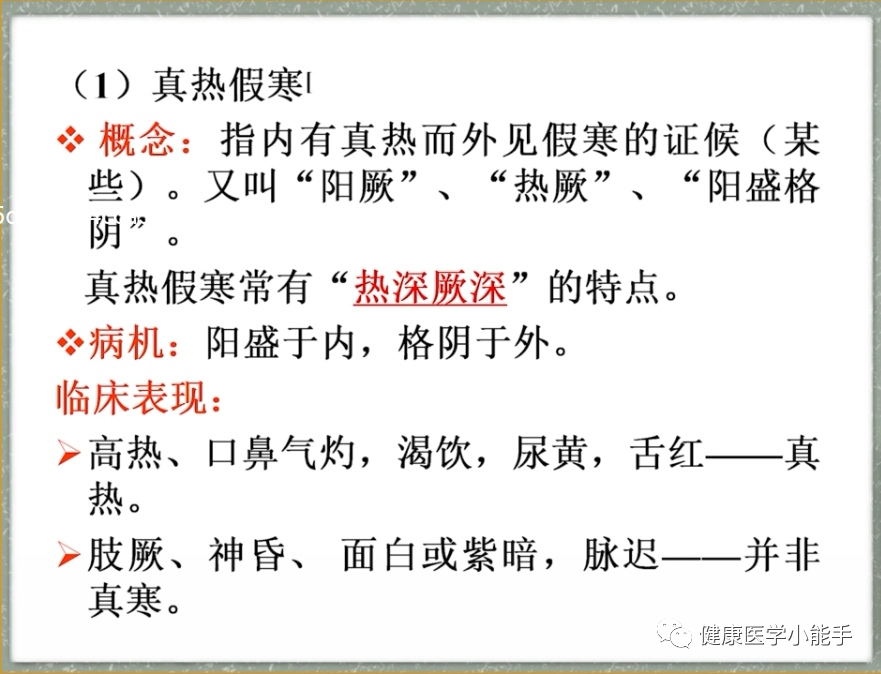
(2) True Cold, False Heat
Concept: Refers to the presence of true cold internally while exhibiting certain false heat externally, also known as Yin excess restraining Yang syndrome.
👉 For example, the body may appear hot, but the person still feels cold, as if the cold penetrates to the bone.
Pathogenesis: Yang Qi is deficient, Yin cold is excessive, forcing the deficient Yang to float upwards and outward (Yin cold is excessive, restraining Yang externally).
Clinical manifestations: No burning sensation in the chest and abdomen, cold limbs, clear and frequent urination, pale tongue, weak pulse.
Facial redness like makeup, irritability, and restlessness, etc.

